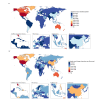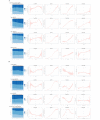Global, Regional, and National Prevalence of Gout From 1990 to 2019: Age-Period-Cohort Analysis With Future Burden Prediction
- PMID: 37285198
- PMCID: PMC10285625
- DOI: 10.2196/45943
Global, Regional, and National Prevalence of Gout From 1990 to 2019: Age-Period-Cohort Analysis With Future Burden Prediction
Abstract
Background: Gout is a common and debilitating condition that is associated with significant morbidity and mortality. Despite advances in medical treatment, the global burden of gout continues to increase, particularly in high-sociodemographic index (SDI) regions.
Objective: To address the aforementioned issue, we used age-period-cohort (APC) modeling to analyze global trends in gout incidence and prevalence from 1990 to 2019.
Methods: Data were extracted from the Global Burden of Disease Study 2019 to assess all-age prevalence and age-standardized prevalence rates, as well as years lived with disability rates, for 204 countries and territories. APC effects were also examined in relation to gout prevalence. Future burden prediction was carried out using the Nordpred APC prediction of future incidence cases and the Bayesian APC model.
Results: The global gout incidence has increased by 63.44% over the past 2 decades, with a corresponding increase of 51.12% in global years lived with disability. The sex ratio remained consistent at 3:1 (male to female), but the global gout incidence increased in both sexes over time. Notably, the prevalence and incidence of gout were the highest in high-SDI regions (95% uncertainty interval 14.19-20.62), with a growth rate of 94.3%. Gout prevalence increases steadily with age, and the prevalence increases rapidly in high-SDI quantiles for the period effect. Finally, the cohort effect showed that gout prevalence increases steadily, with the risk of morbidity increasing in younger birth cohorts. The prediction model suggests that the gout incidence rate will continue to increase globally.
Conclusions: Our study provides important insights into the global burden of gout and highlights the need for effective management and prophylaxis of this condition. The APC model used in our analysis provides a novel approach to understanding the complex trends in gout prevalence and incidence, and our findings can inform the development of targeted interventions to address this growing health issue.
Keywords: Bayesian age-period-cohort analysis; Global Burden of Disease Study 2019; Norped age-period-cohort analysis; age-period-cohort analysis; gout; prediction; prevalence.
©Qiyu He, Tsz-Ngai Mok, Tat-Hang Sin, Jiaying Yin, Sicun Li, Yiyue Yin, Wai-Kit Ming, Bin Feng. Originally published in JMIR Public Health and Surveillance (https://publichealth.jmir.org), 07.06.2023.
Conflict of interest statement
Conflicts of Interest: None declared.
Figures







References
-
- Clebak KT, Morrison A, Croad JR. Gout: rapid evidence review. Am Fam Physician. 2020 Nov 01;102(9):533–8. https://www.aafp.org/link_out?pmid=33118789 d15222 - PubMed
-
- Chandratre P, Roddy E, Clarson L, Richardson J, Hider S, Mallen CD. Health-related quality of life in gout: a systematic review. Rheumatology (Oxford) 2013 Nov;52(11):2031–40. doi: 10.1093/rheumatology/ket265. https://europepmc.org/abstract/MED/23934311 ket265 - DOI - PMC - PubMed
-
- Mody GM. Rheumatology in Africa-challenges and opportunities. Arthritis Res Ther. 2017 Mar 07;19(1):49. doi: 10.1186/s13075-017-1259-3. https://arthritis-research.biomedcentral.com/articles/10.1186/s13075-017... 10.1186/s13075-017-1259-3 - DOI - DOI - PMC - PubMed
-
- Huang C, Wang T, Chen Y, Hu J, Ku P, Hsieh C, Lee C, Kuo F, Lu C, Su C, Liu J, Lin F, Chou Y, Sun C. Gout as a risk factor for acute myocardial infarction: evidence from competing risk model analysis. J Investig Med. 2021 Aug 05;69(6):1161–7. doi: 10.1136/jim-2020-001714.jim-2020-001714 - DOI - PubMed
Publication types
MeSH terms
LinkOut - more resources
Full Text Sources
Medical
Miscellaneous

